Advertisement
Grab your lab coat. Let's get started
Welcome!
Welcome!
Create an account below to get 6 C&EN articles per month, receive newsletters and more - all free.
It seems this is your first time logging in online. Please enter the following information to continue.
As an ACS member you automatically get access to this site. All we need is few more details to create your reading experience.
Not you? Sign in with a different account.
Not you? Sign in with a different account.
ERROR 1
ERROR 1
ERROR 2
ERROR 2
ERROR 2
ERROR 2
ERROR 2
Password and Confirm password must match.
If you have an ACS member number, please enter it here so we can link this account to your membership. (optional)
ERROR 2
ACS values your privacy. By submitting your information, you are gaining access to C&EN and subscribing to our weekly newsletter. We use the information you provide to make your reading experience better, and we will never sell your data to third party members.
Environment
2009 R&D Budget A Tough Sell
Bush's final budget is a mixed bag for science; big changes are expected from Congress
by Lois R. Ember, David J. Hanson, Glenn Hess, Cheryl Hogue, Jeff Johnson, & Susan R. Morrissey
February 18, 2008
| A version of this story appeared in
Volume 86, Issue 7
FACED WITH HUGE DEFICITS in his final year in office, President George W. Bush has proposed a fiscal 2009 research and development budget that is a record high but is unlikely to be passed by Congress. As he did with last year's R&D proposal, Bush strives to boost the funding for certain agencies while balancing the additions with cuts in others.

The Administration has proposed a record $147 billion for R&D for 2009, which is a 2.7% increase over what was appropriated for fiscal 2008. According to the Office of Management & Budget (OMB), $29.4 billion of this increase would be spent on basic research, mostly by the National Institutes of Health. Applied research would receive $27.0 billion, and development, which includes the building and maintenance of labs and the construction of military weapons systems, would receive $84.0 billion, or 57% of the entire R&D budget.
The R&D budget in many ways reflects the President's priorities. Coal and nuclear energy research are slated for increases, while renewable energy and energy efficiency projects are cut. Defense development gets a boost, but defense basic research is reduced. Agencies that are part of the America Competes Act—the National Science Foundation, the Department of Energy's Office of Science, and the National Institute of Standards & Technology—are targeted to receive significant gains. Funding for space exploration at the National Aeronautics & Space Administration is also set to climb, but biomedical research funding at NIH gets no increase at all.
Congress, however, is already expressing its dissatisfaction with this budget. Rep. David R. Obey (D-Wis.), chairman of the House Appropriations Committee, in a statement called the proposal "a dreary and irresponsible rerun of those we have seen for the past eight years." And Rep. Bart Gordon (D-Tenn.), chairman of the Science & Technology Committee, said the R&D budget "proposes an incomplete and short-sighted plan to promote U.S. competitiveness." On the basis of past experience, a lot of adjustments to the numbers will be made before the budget is passed.
The following review of proposed R&D spending at the federal agencies comes with some caveats. The numbers are given mostly as budget obligations, that is, the money that agencies can contract to spend during the fiscal year. The amounts may be more or less than what the agencies actually spend, or outlay, during the year.
Also, the federal budget is a complicated document with various ways of adding up programs and totals. As a result, sometimes the agency or department figures and the totals from OMB are not the same and may be published in different places as different amounts. These variations are usually small and reflect alternative methods of dividing funds.
NSF. The President's 2009 budget includes a significant 13% increase for NSF to $6.9 billion. This increase makes up for the less-than-requested funding received this year and provides the level of funding authorized in the America Competes Act, passed last summer.
At the foundation's budget rollout briefing, NSF Director Arden L. Bement Jr. stated that although the agency was disappointed with the 2008 omnibus appropriations, it is pleased with the increases proposed in the 2009 budget. The 2008 appropriations threw NSF's growth as authorized by the America Competes Act "essentially off the rails, but I am optimistic that the 2009 budget will get us back on track," he said.
Under the proposed budget, Research & Related Activities (R&RA) is slated to receive the bulk of the foundation's increase, bringing total funding to $5.6 billion. This amount is 16% more than the 2008 estimated level of $4.8 billion.
The largest increase in funds within R&RA is proposed to go to the Mathematical & Physical Sciences Directorate (MPS), which is scheduled to grow by 20% to $1.4 billion. Within MPS, the Chemistry Division is slated for the largest percentage gain, 26%, bringing its total budget to $245 million, and the Materials Research Division expects to see the largest dollar increase-$64 million-to bring its total to $325 million.
The jump in R&RA funding will also be used to support four major cross-foundation initiatives. These programs are designed to have a transformative impact across science and technology, with a focus on areas of national priority such as manufacturing, computing, energy, cybersecurity, sensors, and materials.
The Cyber-Enabled Discovery & Innovation initiative is set to more than double in 2009, growing to $100 million from $48 million in 2008. The overall goal is to advance science and engineering along fundamentally new pathways opened by computational capabilities.
The initiative called Science & Engineering Beyond Moore's Law will receive $20 million. The investment will go toward keeping the U.S. at the forefront of communications and computation capability beyond the physical and conceptual limits of current systems.
A $15 million investment for the Adaptive Systems Technology initiative will be used to generate pathways and interfaces between human and physical systems to aid development of novel adaptive systems; hybrid computer architectures; and computer-based, self-paced learning and training tools.
Finally, the Dynamics of Water Processes in the Environment initiative is slated for a $10 million investment to help increase the basic understanding of the world's freshwater systems and provide the scientific basis for decision-making about water resources.
The 2009 budget will also allow the agency to "maintain strong, sustained support for all disciplines," Bement noted. This support will translate into funding for an additional 1,370 grants, which will increase the grant success rate from 21% in 2008 to 23% in 2009.
The foundation will use its boost in funding to make an additional $15 million investment in its Science & Technology Centers Program, which will allow NSF to add five to seven centers to its portfolio.
NSF's investment in people will remain strong. The agency proposes to increase funding for its flagship program for young faculty—the Faculty Early Career Development Program—by $14 million to $182 million. And it will increase funding of its Graduate Research Fellowship program by $29 million, or 30%, allowing it to support an additional 700 fellows, for an estimated total of 3,075 fellows in 2009.
The one area that is not set to increase in 2009 is Major Research Equipment & Facilities Construction, which is marked for a 33% cut in funds. This drop is due in part to the completion of some projects and to a hold on funding for a set of projects that have been deemed not mature enough to justify additional construction funding at this time.
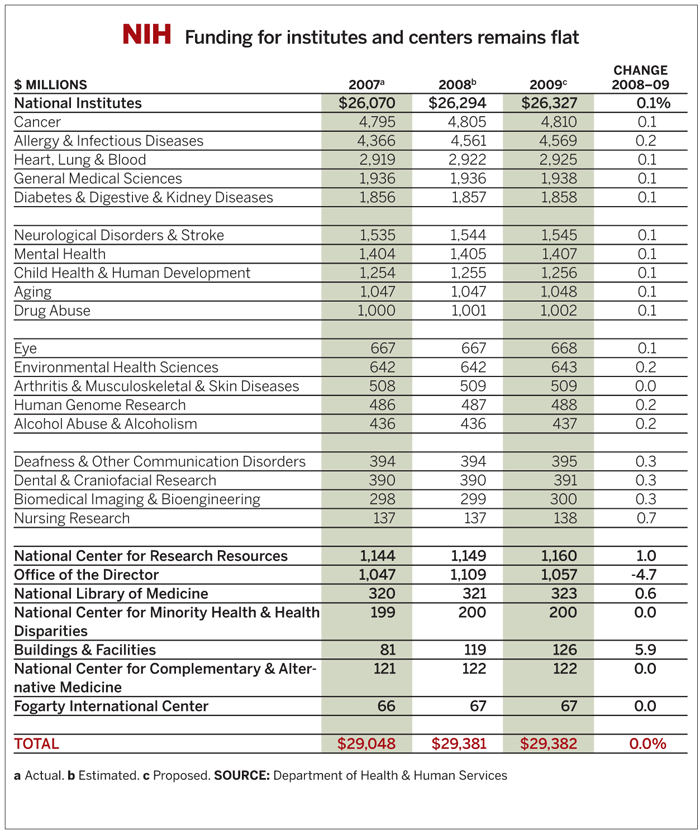
NIH. The proposed 2009 spending for NIH holds the agency's budget at $29.4 billion. This flat funding marks the sixth year that the agency's budget growth has fallen well below the rate of biomedical inflation, which is estimated to be 3.7% in 2008.
Like the agency's overall budget, the funding levels for each of its 27 institutes and centers will be essentially flat. The only significant changes will be to the Office of the Director budget, which will drop by nearly 5% to $1.1 billion, and the Buildings & Facility budget, which will grow by nearly 6% to $126 million.
Although it is not requesting new money for 2009, NIH has identified three strategic priorities: support for new investigators, the NIH Director's Bridge Award, and the NIH Common Fund.
To support new investigators, the 2009 budget will continue to provide money for Pathway to Independence Awards. These grants allow postdoctoral scientists to receive both mentored and independent research support from the same award. An additional 170 awards in 2009 will bring the total number of awardees supported to approximately 500 at a total cost of $71 million. NIH will also provide $56 million of its Common Fund to support 25 New Innovator Awards, for scientists who take highly innovative approaches to major research challenges.
The Bridge Award program is slated to receive $91.2 million to support well-established, meritorious investigators with little or no other significant research funding.
NIH will also continue to invest in its Common Fund by providing an increase of $38 million from 2008, for a total budget of $534 million in 2009. The funds will be used to continue support of projects on the human microbiome and epigenomics. A $46 million chunk of the budget will be set aside to support new projects developed during 2008.
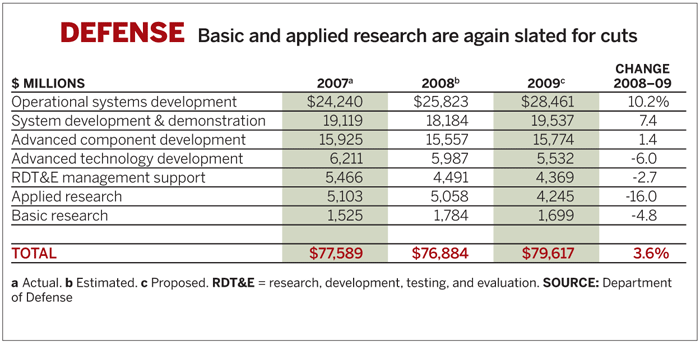
DEFENSE. Most of the federal spending on R&D historically goes to the Department of Defense. DOD's share briefly dropped below 50% during the Clinton Administration, but it has risen to 55% for fiscal 2009. For next year, Defense research, development, testing, and evaluation (RDT&E) programs are allotted just more than $79.6 billion, which the Administration lists as a 3.6% increase.
The actual increase is less, because the Administration has adjusted all of its figures by eliminating all congressionally mandated spending-or earmarks-from 2008. If earmark spending is left in, the actual increase is less than 1%.
The research portion of RDT&E is affected by this budgetary trick. Funds for basic research at DOD would rise to $1.7 billion next year under the Administration's proposal. This is listed as a 4% increase after 2008 earmarks are deleted. If the earmarks are counted, basic research funds would be down 4.8%, with a loss of $85 million. DOD basic research funds are important because they support much of the academic research in engineering. According to data from 2005, Defense provided 85% of all mechanical engineering research funds, 65% of electrical engineering funds, and 36% of all funds for academic materials engineering research.
The DT&E segment of the category would receive most of the funding. Spending on activities such as developing prototype systems, developing engineering and manufacturing systems, and testing and building new weapons would receive $74.4 billion for fiscal 2009, according to OMB. This alone is more than half of all federal R&D spending proposed for 2009.
Some specific Defense programs have been slated to increase next year. The Defense Advanced Research Projects Agency would get an 11% boost to $3.3 billion, and the Missile Defense Agency budget would increase from $8.6 billion to $8.9 billion, a 3.5% rise.
HOMELAND SECURITY. The government-wide budget for homeland security soars nearly 11% to $66 billion in a fiscal 2009 budget that places severe constraints on many other key domestic programs. Thirty-two agencies, including the Smithsonian Institution, partake in domestic security activities. But five agencies—the departments of Homeland Security (DHS), Defense, Health & Human Services, Justice, and Energy—account for the bulk of the new homeland security funds. Of the five, DHS receives the lion's share—nearly $38 billion—in fiscal 2009. That amounts to an 8.5% increase over fiscal 2008 funding, but most of the $38 billion goes to non-research-related activities.
When non-R&D funding is subtracted from all homeland-security-related activities, the numbers contract. Government-wide homeland security R&D funding for fiscal 2009 totals $5.5 billion, reflecting a 10% increase over the previous fiscal year. And most of this funding—$1.9 billion—supports biodefense research at the National Institute of Allergy & Infectious Diseases. Another $1.5 billion—a 16% boost—goes to DOD, largely for its chemical and biological defense programs. The Environmental Protection Agency, for drinking water protection programs, and Department of Agriculture, for food safety research, also receive hefty increases.
DHS's R&D budget totals $1.1 billion, a 4.5% increase over the fiscal 2008 R&D request. The $1.1 billion figure excludes $2.2 billion for Project BioShield, a program to procure and stock pharmaceuticals against chemical, biological, and radiological incidents. It is unclear why, but the budget books lump the $2.2 billion in the R&D account as facilities and equipment. To further complicate the issue, this money was appropriated in 2004 but only released in fiscal 2009. Experts such as Kei Koizumi, director of the R&D Budget & Policy Program at American Association for the Advancement of Science, are still delving into the numbers for a possible explanation.
As they did in fiscal 2008, two main components make up DHS's R&D portfolio this year: the Science & Technology Directorate (S&T) and the Domestic Nuclear Detection Office (DNDO).
DNDO's R&D programs receive a 3.3% boost, from $324 million in fiscal 2008 to $334 million in fiscal 2009. Some of the new R&D funding will explore breakthroughs in radiation detection materials to improve on current materials' sensitivity, energy resolution, and cost.
Advertisement
In fiscal 2008, DNDO received a hefty 19% increase in R&D funding, so the dramatic drop in R&D funding growth in fiscal 2009 may reflect "technology transitions from R&D to procurement," Koizumi said. DNDO's procurement funding increases "dramatically" in fiscal 2009, he noted.
Percentagewise, S&T fares better than DNDO, up 6.5% from $692 million in fiscal 2008 to $737 million in 2009. Like a shape-shifter, much of S&T's R&D budget is in constant flux, and fiscal 2009 is no exception.
For example, funding for research on chemical and biological countermeasures drops nearly 4% to $200 million in fiscal 2009 from $208 million in fiscal 2008. Funding for research on explosives countermeasures increases nearly 24% to $96 million in fiscal 2009, up from $78 million in fiscal 2008. Much of the latter research is devoted to countering terrorist use of improvised explosive devices.
Although it's not part of the R&D budget, DHS will spend about $16 million to begin operations at its National Biodefense Analysis & Countermeasures Center at Ft. Detrick, Md. This controversial center will include high-containment (BSL-4 level) lab space for biological threat characterization and bioforensic research.
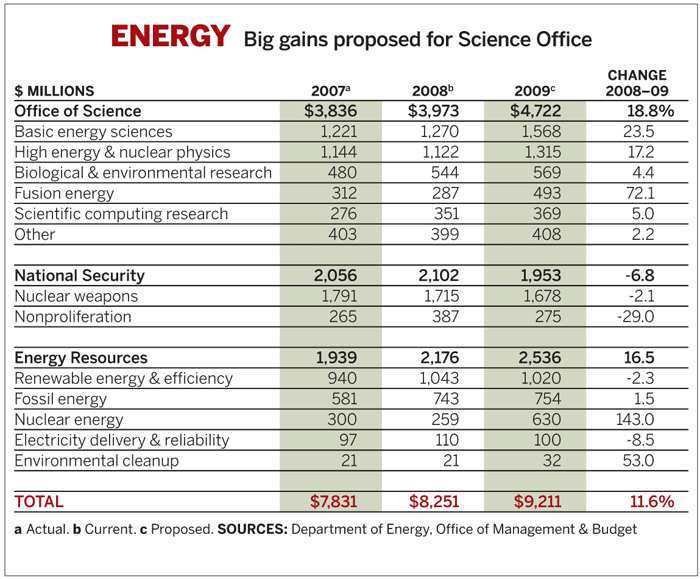
ENERGY. The Department of Energy fared well in the Administration's proposed 2009 budget. Indeed, the President proposes a jump of more than $1 billion, taking the department's budget to a record-setting $25 billion, of which $9.2 billion is dedicated to science.
The proposal is particularly good for science, with the Office of Science—which is part of the U.S. competitiveness initiative—receiving a 19% boost. It is also good for coal and nuclear energy, which would receive large boosts compared with last year. It is not so good for renewable energy and efficiency R&D, however, which would be hit with a cut.
The proposal shows remarkable consistency for the Bush Administration, closely mirroring the President's pro-coal and nuclear priorities since he took office. Congress is likely to show equal consistency, however, by slicing and dicing the Bush proposals as it has done in past years.
"We are delighted with the request," said Raymond L. Orbach, undersecretary for science, at DOE's budget briefing. "DOE supports more than 40% of the physical science research in the U.S., and this budget is a vote of confidence in the Office of Science."
Orbach played down the size of the 19% increase for the Science Office, saying despite appearances it is not a huge jump, and it is necessary to make up for congressional cutbacks of the past few years. He also warned that if Congress cuts deeply into the proposal, "we are in real trouble."
"The U.S. is losing its competitive edge in the physical sciences," Orbach said. "This is a critical year for U.S. competitiveness."
Orbach singled out several new proposed programs of importance to the research community, particularly a $100 million plan to fund several Energy Frontier Research Centers. The program would provide five-year, $2 million to $5 million annual basic research grants to universities, industries, and federal laboratories. Funding would be competitive, and the application process should begin in a few months, Orbach said. He outlined a long list of specific research areas he was interested in funding, which include direct conversion of solar energy to electricity and chemical fuels, electrical energy storage technologies for stationary and mobile sources, and various carbon sequestration technologies.
In other science areas, this year's budget proposal would also increase funding for the International Thermonuclear Experimental Reactor, a fusion energy demonstration project under construction in France. The Administration had sought $160 million last year, but Congress gave only $10 million. This year, the Administration is seeking $214 million to partially make up the difference.
Historically, Orbach noted, the Office of Science has had many supporters in Congress. But over the past two years, Congress has shaved about $750 million from the Administration's request. This year, Orbach's science salesmanship is likely to be put to a difficult test. "Our job," he said frequently during the budget briefing, "is to convince the American public that long-term science investments are critical to the nation."
Also proposed for big boosts are nuclear energy and coal-fired electricity technologies. The entire nuclear energy program is proposed for a 37% increase in 2009, to $1.4 billion. This budget request marks the largest ever increase and represents a 330% rise over what President Bush first requested when he took office, said Assistant Secretary for Nuclear Energy Dennis R. Spurgeon. Nuclear energy research would get a whopping 143% jump to $630 million.
Congress, however, will play a role in determining the final amount as it did last year. For 2008, the Administration sought $395 million for its plan to start the nation on a path to reprocessing nuclear spent fuel. Congress opposed the program—the Global Nuclear Energy Partnership (GNEP)—and cut its funding to $180 million. For 2009, the Administration seeks $302 million for GNEP, but there are no signs that Congress' view of the expensive and complex program has softened. The Administration is also losing one of its most powerful nuclear allies, Sen. Pete V. Domenici (R-N.M.), who will retire this year.
Coal R&D is proposed for an increase in spending, rising 26% to $624 million primarily for technologies to capture and sequester carbon dioxide. The Administration recently announced its intention to overhaul the multi-billion-dollar FutureGen program to build and operate a large integrated gasification combined-cycle plant for electricity generation. The Administration will now fund a host of smaller projects to capture and sequester CO2 at various sites around the country.
For energy efficiency and renewable energy R&D, the largest chunk of funding is slated to go to two areas: biomass and biorefinery systems ($225 million, up 13%) and vehicle technology development ($221 million, up 4%). Next comes solar energy ($156 million, down 7%) and energy efficiency building technologies ($124 million, up 13%). Overall, however, the entire energy efficiency and renewable energy program would be cut by 27% to $1.3 billion.
The lion's share of this cut is to an energy efficiency program to weatherize low-income housing. It is proposed for a $223 million, or 80%, cut. DOE officials acknowledge the weatherization program saves a lot of energy and helps low-income families, but department officials say the program is inconsistent with other more application-focused DOE programs. Congress is unlikely to agree. Instead, as in previous years, Congress will probably cut other DOE programs and shift funds to weatherization, thereby putting a dent in other DOE R&D areas.
At the first congressional hearing on the budget, Sen. Jeff Bingaman (D-N.M.) said as much, promising to reverse "DOE's ill-timed budget cut" to the weatherization program.
NASA. The Administration is requesting a nearly 3% increase in NASA's budget for 2009, bringing its total budget to $17.6 billion. The agency will not make any strategic changes in 2009 and will continue its support of human space exploration as well as its Earth and space science programs.
To advance Earth and space science, the proposed 2009 budget includes $4.4 billion to operate 55 spacecraft and invest in future missions. These future missions include the development of five Earth-observing missions as recommended by the National Research Council's decadal Earth sciences survey. This development will be supported with a $910 million investment over the next five years. NASA will also launch an additional seven new Earth-observing missions during the next several years.
Under the 2009 requested budget, NASA will invest $3.5 billion in new vehicles and technologies to make possible sustained and affordable human and advanced robotic exploration of space. This request includes $500 million for the development of commercial space capabilities.
Funding for the International Space Station would also grow from $1.8 billion to $2.0 billion in the proposed 2009 budget. Some of this funding will support an increase in the number of station crew, which is expected to grow from two to six in 2009 as the station nears completion. Funding for the space shuttle program, however, would drop by nearly $300 million to $3.0 billion as NASA continues to move toward retiring its fleet of shuttles in 2010.
"This year's NASA budget is likely to provoke sharp debate in Congress, as we must determine what the agency's priorities should be," remarked House Science & Technology Committee ranking member Rep. Ralph M. Hall (R-Texas) in a statement. He added that the committee will be looking closely at NASA as it takes up the reauthorization of the agency this year.
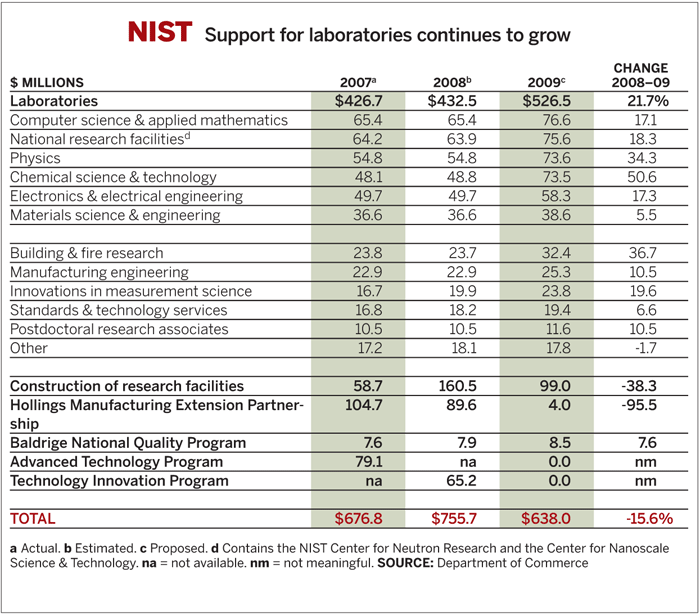
COMMERCE. Funding for R&D within the Commerce Department is mainly focused on its two primary science agencies—NIST and the National Oceanic & Atmospheric Administration. The Administration's proposed 2009 budget includes increases for both.
NIST, which is one of the three agencies targeted for a 10-year budget doubling by the America Competes Act, is slated to receive $638 million in 2009. This amount is down nearly 16% from the 2008 level; however, those levels include earmarks that are on the order of $83 million, according to the Office of Science & Technology Policy.
Advertisement
Funding for basic research at NIST is set to grow by 22% in 2009 to a total of $527 million. This increase will go in part to support 10 initiatives from 2008 and four new ones. These new initiatives include Nanotechnology: Environmental, Health & Safety Measurements & Standards, which will receive $12 million; Measurements & Standards To Accelerate Innovation in the Biosciences, which will get $10 million; Comprehensive National Cybersecurity Initiative: Leap-Ahead Technologies, which will get $5 million; and Going At Light Speed: Optical Communications & Computing, which will get $5.8 million.
The 2009 requested budget also includes $43.5 million to complete laboratory space on NIST's Boulder, Colo., campus. The construction budget includes $13 million for an expansion of the Joint Institute for Laboratory Astrophysics, now known simply as JILA, a joint institute of NIST and the University of Colorado.
Taking a big hit in the proposed budget, however, is NIST's Industrial Technology Services (ITS), which includes the Hollings Manufacturing Extension Partnership (HMEP), the Advanced Technology Program, and the congressionally mandated Technology Innovation Program. Under the 2009 request, these services would be effectively zeroed out, with HMEP dropping by 96% to $4.0 million and the other two programs getting no funding at all.
"This budget continues the Administration's commitment to work toward a doubling of NIST's core budget," said NIST Acting Director James M. Turner in a statement. But "this budget also reflects some difficult decisions about priorities and reflects the President's guidance to restrain spending," he added, specifically pointing to ITS programs.
For NOAA, the 2009 request calls for the agency to receive $4.1 billion, a 5.3% growth over its 2008 funding. The budget includes increases for NOAA's satellite program, with $81 million tagged for improved climate monitoring and prediction. NOAA will also increase its investments in the President's Ocean Initiative by $49 million and will allocate $78 million for ocean science and research.
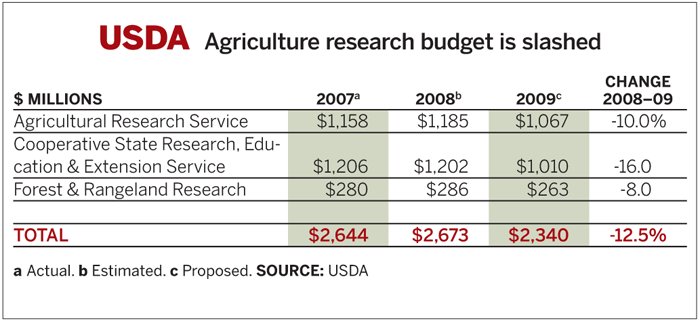
AGRICULTURE. The Administration's budget calls for $95 billion in total spending for discretionary and mandatory USDA programs in fiscal 2009, roughly the same amount that will be spent in the current fiscal year.
"This budget aims to enhance those programs with a proven track record for achieving results and reflects the President's goal to keep spending under control to reduce the deficit," said Agriculture Secretary Edward Schafer.
As has been the practice in previous years, the Administration is proposing to eliminate or reduce funding for more than 30 discretionary programs. Congress has thwarted such efforts in the past, and lawmakers such as Sen. Tom Harkin (D-Iowa) and Rep. Rosa DeLauro (D-Conn.) say they intend to restore the funds again this year.
USDA research programs are among those targeted for reduction by the White House. Spending for programs that range from food safety to farm-based energy would drop from nearly $2.7 billion in 2008 to just over $2.3 billion in 2009, a decrease of almost 13%. Many of the cuts would come from ignoring congressional earmarks for various research projects, according to Schafer. He said $185 million of research earmarks are not funded.
The Agricultural Research Service (ARS), the department's main in-house research arm, would receive $1.1 billion under the Administration's 2009 budget request, down from $1.2 billion in 2008.
The budget for ARS includes an additional $5.9 million for renewable energy research aimed at improving the efficiency of converting energy crops and crop residues into biofuels. An additional $4.6 million would be devoted to the discovery of novel vaccines to protect livestock, and $4.3 million would go to developing technology to control emerging plant diseases.
The Cooperative State Research, Education & Extension Service (CSREES) would also see its budget decline from $1.2 billion in 2008 to slightly more than $1 billion in 2009, a 16% cut. At CSREES, funding for the National Research Initiative, USDA's primary competitive research grants program, would be set at $257 million, up from $191 million in 2008.
USDA is seeking $263 million for forest and rangeland research, an 8% decline from the $286 million spent in 2008. The program supports specific research needs that arise from managing the national forest system.
The spending recommendations come as Congress and the Administration are trying to reauthorize a 2002 farm law that will define funding levels for many agriculture programs over the next five years. Officials expect some fiscal 2009 proposals to change after the new farm bill is enacted into law.
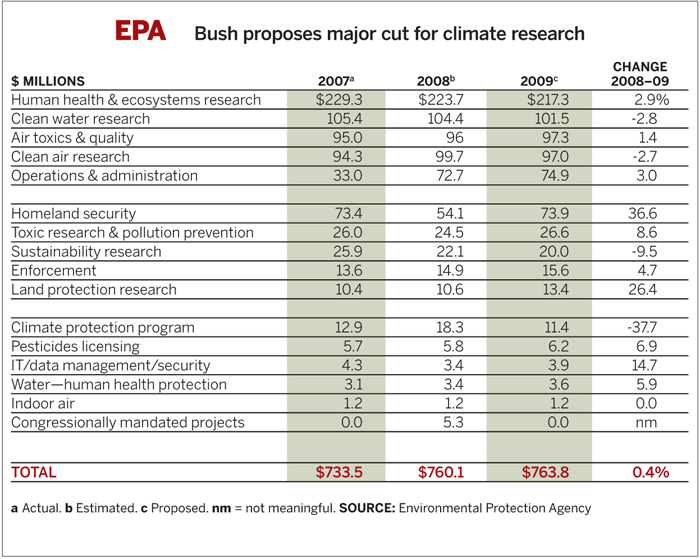
EPA. Bush's 2009 budget request of $763.8 million for EPA is virtually flat compared with the $760.1 million Congress appropriated for the agency in 2008. It is, nonetheless, slightly higher than the $754.4 million the President proposed for 2008.
The bottom line is that the Administration wants to boost EPA's science and technology spending on homeland security and offset this increase largely with cuts to the agency's climate-change research.
The President proposed an increase of $19.8 million for EPA's homeland security activities. This would raise the $54.1 million Congress enacted for these activities in 2008 by 37% to $73.9 million.
The extra money would go toward efforts to prevent and detect chemical or biological attacks on public water utilities. In addition, the agency would enhance research on anthrax, including developing methods to detect the microbe, determining the bacterium's deposition and adhesion properties, and devising methods to decontaminate anthrax effectively in wide areas while minimizing the generation of waste.
EPA spending related to toxic substances and pollution prevention would rise from $24.5 million to $26.6 million under the 2009 budget proposal. Part of the extra money would allow the agency to beef up research on how nanomaterials move through the environment and on their eventual fate. EPA wants investigators to determine the physicochemical properties that control the movement of nanomaterials through soil and aquatic ecosystems.
In addition, the budget proposal would boost the agency's computational toxicology work from $12.1 million to $14.9 million. EPA is using computer-assisted toxicity testing to assess pesticides and industrial chemicals.
Meanwhile, the President wants to chop $10 million-more than one-quarter of the current budget-from the agency's climate-change-related efforts and climate-related air pollution research that together are getting $38 million in 2008. EPA Administrator Stephen L. Johnson, however, insists that the President's budget request includes "sufficient funding" for climate change. "We feel confident that we're on course" regarding climate-change activities, he said.
Another program targeted for a budget cut is EPA's research on chemicals suspected of disrupting the endocrine system, with its current level of $10.3 million proposed to be pared to $9.5 million.
Clean-water research would also get trimmed under the President's plan. Part of the $101.5 million proposed for EPA's water-related research for 2009 would fund research on the impacts of CO2 stored underground on the quality of drinking water drawn from aquifers.
THE BUDGET PROCESS. The fiscal 2009 budget now goes to the House and Senate Appropriations Committees, where it is divided into several appropriations bills. Various committees will hold hearings on each bill, and legislation will emerge that sets the levels of spending for all federal departments and agencies. The numbers approved by Congress may be different from those originally proposed by the Administration, as Congress has expressed its dissatisfaction with the R&D budget. The whole process is supposed to be completed and the bills signed by the President by Sept. 30, the last day of fiscal 2008.




Join the conversation
Contact the reporter
Submit a Letter to the Editor for publication
Engage with us on Twitter